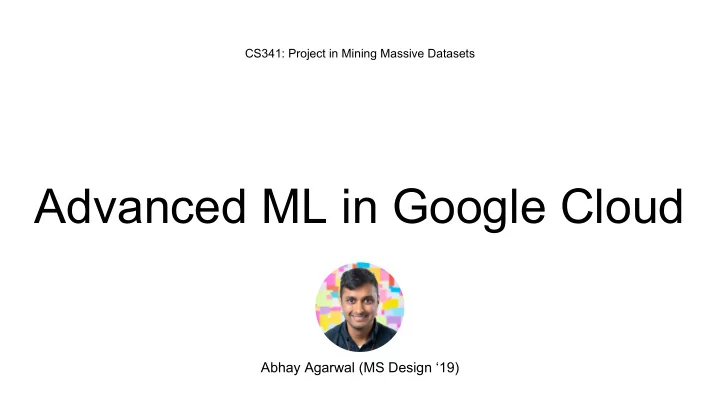

CS341: Project in Mining Massive Datasets Advanced ML in Google Cloud Abhay Agarwal (MS Design ‘19)
Agenda ● General Notes on Pipelining ● Some History ● Distributed Processing in Tensorflow ● Cloud ML Engine in Google Cloud ● Misc. features and TPUs
Background on ML pipelines ● What is an ML pipeline?
Background on ML pipelines ● What is an ML pipeline? ● Why do we need an ML pipeline? Local machine is not fast enough to run the computations effectively Require specialized hardware Hard drive isn’t large enough to store data Want to do stream rather than batch processing Want to parallelize tasks using multiple machines Want to collaborate on development without replicating dev state Want to get several of these features “for free” without changing my workflow (too much)
… a bit of history of server pipelining Here’s a very basic way to orchestrate $ for SVR in 1 2 3 your servers… > do > ssh root@server0$SVR.example.com -p ******** What’s wrong? > # DO SOMETHING > done
… a bit of history of scaling datacenters Here are slightly less basic way to orchestrate your servers:
Types of pipelines
A Note on GPU sharing ● GPUs are very difficult to virtualize for obvious reasons… ○ CUDA (Nvidia GPU API) is essentially written for single processes ○ GPU memory-sharing limits processing capabilities ○ Time-sharing: interleave processes in time domain (doesn’t add any savings…) ● Though, this will probably change in our lifetime
Easy Mode: TensorFlow Cluster Primitive ● Create multiple tensorflow processes ● Communicate over sockets ● Can live on multiple servers (with tensorflow server daemon) ● Can live on same machine with different GPUs or with same CPUs
Easy Mode: TensorFlow Cluster Primitive with tf.device("/job:ps/task:0"): weights_1 = tf.Variable(...) biases_1 = tf.Variable(...) with tf.device("/job:ps/task:1"): weights_2 = tf.Variable(...) biases_2 = tf.Variable(...) with tf.device("/job:worker/task:7"): input, labels = ... layer_1 = tf.nn.relu(tf.matmul(input, weights_1) + biases_1) logits = tf.nn.relu(tf.matmul(layer_1, weights_2) + biases_2) # ... train_op = ... So why might you want to do this? with tf.Session("grpc://worker7.example.com:2222") as sess: for _ in range(10000): sess.run(train_op)
Easy Mode: TensorFlow Cluster Primitive So why might you want to do this? ● Lots of data and lots of GPUs ● Data >> learning rate ● Certain algorithms benefit from this kind of parallelism (e.g. A3C) ● Gradients roughly commutative
Easy Mode: TensorFlow Cluster Primitive Merging gradients ● Synchronous: Gradient Averaging ● Asynchronous: Gradient aggregation
Easy Mode: TensorFlow Cluster Primitive ● Takeaways: ○ Tensorflow can abstract out between-process or between-machine communication ○ Potential massive time savings for compute-intensive network training ● Future ○ Potential for containerization (e.g. Kubernetes-style) ○ Potential for high-level software abstraction (e.g. Spark-style)
Cloud ML ● Simple API for testing and deploying tensorflow/python code ● Local development environment ○ Single node mode ○ Distributed mode ● Cloud deployment functionalities ○ Online prediction (i.e. serverless event-driven) ○ Batch prediction
Cloud ML - local testing Specify env vars: MODEL_DIR=output TRAIN_DATA=$(pwd)/data/adult.data.csv EVAL_DATA=$(pwd)/data/adult.test.csv Build and train your model locally: gcloud ml-engine local train \ --module-name trainer.task \ --package-path trainer/ \ --job-dir $MODEL_DIR \ -- \ --train-files $TRAIN_DATA \ --eval-files $EVAL_DATA \ --train-steps 1000 \ --eval-steps 100 Inspect results in Tensorboard: tensorboard --logdir=$MODEL_DIR gcloud ml-engine models list
Cloud ML - deploy remotely Create a cloud storage bucket and upload your data: gsutil mb -l $REGION gs://$BUCKET_NAME Now point your environment vars to the new data: TRAIN_DATA=gs://$BUCKET_NAME/data/adult.data.csv EVAL_DATA=gs://$BUCKET_NAME/data/adult.test.csv TEST_JSON=gs://$BUCKET_NAME/data/test.json OUTPUT_PATH=gs://$BUCKET_NAME/$JOB_NAME And run a (slightly modified) command: gcloud ml-engine jobs submit training $JOB_NAME \ --job-dir $OUTPUT_PATH \ --runtime-version 1.4 \ --module-name trainer.task \ --package-path trainer/ \ --region $REGION \ -- \ --train-files $TRAIN_DATA \ --eval-files $EVAL_DATA \ --train-steps 1000 \ --eval-steps 100 \ --verbosity DEBUG gcloud ml-engine models list
Cloud ML - train remotely gcloud ml-engine models list
Cloud ML - deploy model MODEL_NAME=census MODEL_BINARIES=gs://$BUCKET_NAME/census_single_1/export/census/1527087194/ gcloud ml-engine versions create v1 \ --model $MODEL_NAME \ --origin $MODEL_BINARIES \ --runtime-version 1.4 gcloud ml-engine models list
Cloud ML - productize model gcloud ml-engine predict \ --model $MODEL_NAME \ --version v1 \ --json-instances \ ../test.json gcloud ml-engine models list
Cloud ML - further features ● Distributed mode (runs multiple parallel workers) ● Hyperparameter Tuning (trains multiple concurrent models and selects best) ● Easy to connect GPUs and TPUs gcloud ml-engine models list
Cloud ML - Using TPUs ● Disclaimer: I have not used TPUs in my work ● What is a TPU?
Cloud ML - Using TPUs ● Disclaimer: I have not used TPUs in my work ● What is a TPU? ● Results are mixed ○ Hosted GPUs are more predictable and not necessarily slower ○ TPUs are more capable for inference but not necessarily training ○ Fine tuning/optimizing DL training is key ● https://cloud.google.com/ml-engine/docs/tensorflow/using-tpus
Recommend
More recommend